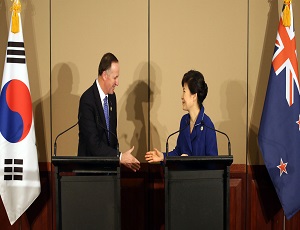 SHANGHAI – On November 15th, New Zealand and South Korea concluded negotiations on a bilateral free-trade agreement (FTA). The announcement was made on the sidelines of the G20 Leaders’ Summit in Brisbane, Australia.
SHANGHAI – On November 15th, New Zealand and South Korea concluded negotiations on a bilateral free-trade agreement (FTA). The announcement was made on the sidelines of the G20 Leaders’ Summit in Brisbane, Australia.
Talks over the agreement first began in 2009 but were impeded by concerns over the impact New Zealand agricultural exports might have on the Korean market. These issues were resolved in February 2014 with the decision to slowly phase out New Zealand’s tariffs, providing an incubation period for domestic producers.
New Zealand’s Prime Minister John Key has affirmed the importance of New Zealand’s economic relationship with South Korea. As of June 2014, South Korea is New Zealand’s sixth largest export destination for goods and services and its eighth largest import source. The total value of bilateral trade is $3.2 billion.
RELATED: New Zealand’s Business Sector Pushes for a Slew of New FTAs in Asia
The FTA will initially eliminate tariffs on 48 percent of New Zealand’s exports, which is currently valued at $230 million per year. This means the deal will result in a total tariff cut of $65 million in the first year alone. The final draft seeks to completely eliminate duties within 15 years. In addition, the FTA will cover rules of origin, customs procedure, and mechanisms to address non-tariff measures such as allowing self-declaration on the origin of goods.
Specific New Zealand exports slated for change include:
- 45 percent rate on kiwifruit;
- 5 percent on sheep meat;
- 40 percent levy on beef;
- 89 percent tariff on butter.
New Zealand failed to reach an accord with South Korea to erase milk powder tariffs, primarily due to high Chinese demand and South Korea’s competitive position, but New Zealand managed to strike a deal on cheese and infant formula exports.
Squids are also excluded in the FTA, with New Zealand’s fishing industries required to pay a 22 percent tariff to export squid to South Korea. A total of 199 items will be exempt from the FTA, including rice, natural honey, apples, pears and garlic.
As for South Korea, tariffs will be eliminated on 48.3 percent of its imports and 96.5 percent of its import tariffs within 20 years. Further benefits include the establishment of an offshore processing zone committee to better administer products manufactured in the Kaesong Industrial Complex located in North Korea. Additionally, the South Korean working holiday quota will be increased from 1,800 to 3,000 persons a year, and temporary employment entries will increase to 200 a year.
RELATED: New Zealand-Vietnam DTA Goes Into Effect
A nation-wide joint study conducted in 2007 calculates that the FTA will boost New Zealand’s economy by $4.5 billion and South Korea’s by $5.9 billion over the next two decades, with the majority of immediate value coming from tariff savings. The treaty will also encourage further exports of electronics, automotive parts, and other manufactured goods from New Zealand.
New Zealand Trade Minister Tim Groser stated he is confident that New Zealand’s exports will expand significantly in the upcoming decade. He asserts that the FTA is a key step for both countries to become proactively involved in the global market.
The final draft of the agreement is expected to be signed later this year upon legal verification and translation. The FTA is written in the same legal language and terms as South Korean FTAs with the US, Canada and Australia, which is expected to expedite the process.
“It’s a high quality deal. It was always going to be a tough negotiation but we have got ourselves now back into a level playing field with those countries that compete heavily in the Korean market and I think a lot of New Zealand industry will be happy about the outcome,” Prime Minister Key stated in Brisbane.
|
Asia Briefing Ltd. is a subsidiary of Dezan Shira & Associates. Dezan Shira is a specialist foreign direct investment practice, providing corporate establishment, business advisory, tax advisory and compliance, accounting, payroll, due diligence and financial review services to multinationals investing in China, Hong Kong, India, Vietnam, Singapore and the rest of ASEAN. For further information, please email asia@dezshira.com or visit www.dezshira.com. Stay up to date with the latest business and investment trends in Asia by subscribing to our complimentary update service featuring news, commentary and regulatory insight.
|
![]()
Manufacturing Hubs Across Emerging Asia
In this issue of Asia Briefing Magazine, we explore several of the region’s most competitive and promising manufacturing locales including India, Indonesia, Malaysia, Singapore, Thailand and Vietnam. Exploring a wide variety of factors such as key industries, investment regulations, and labor, shipping, and operational costs, we delineate the cost competitiveness and ease of investment in each while highlighting Indonesia, Vietnam and India’s exceptional potential as the manufacturing leaders of the future.
 The Gateway to ASEAN: Singapore Holding Companies
The Gateway to ASEAN: Singapore Holding Companies
In this issue of Asia Briefing Magazine, we highlight and explore Singapore’s position as a holding company location for outbound investment, most notably for companies seeking to enter ASEAN and other emerging markets in Asia. We explore the numerous FTAs, DTAs and tax incentive programs that make Singapore the preeminent destination for holding companies in Southeast Asia, in addition to the requirements and procedures foreign investors must follow to establish and incorporate a holding company.
 An Introduction to Tax Treaties Throughout Asia
An Introduction to Tax Treaties Throughout Asia
In this issue of Asia Briefing Magazine, we take a look at the various types of trade and tax treaties that exist between Asian nations. These include bilateral investment treaties, double tax treaties and free trade agreements – all of which directly affect businesses operating in Asia.



